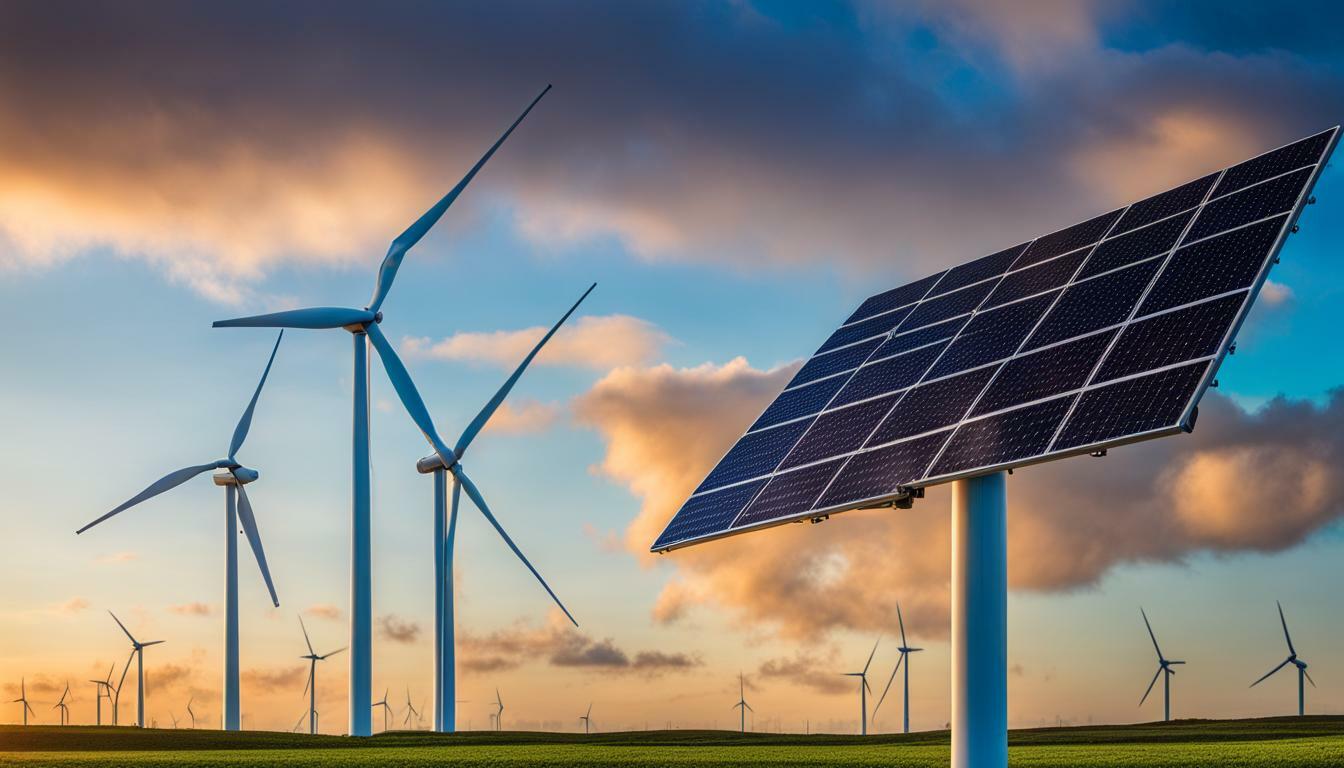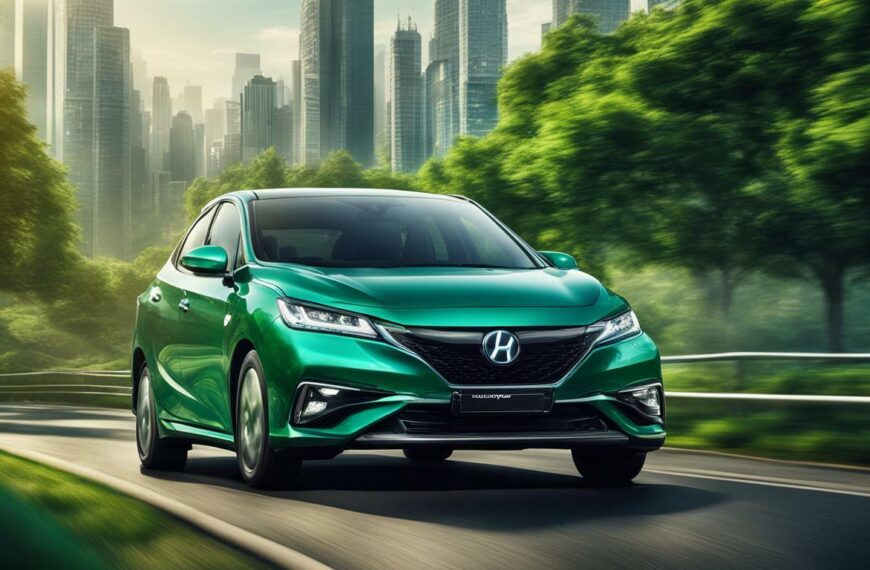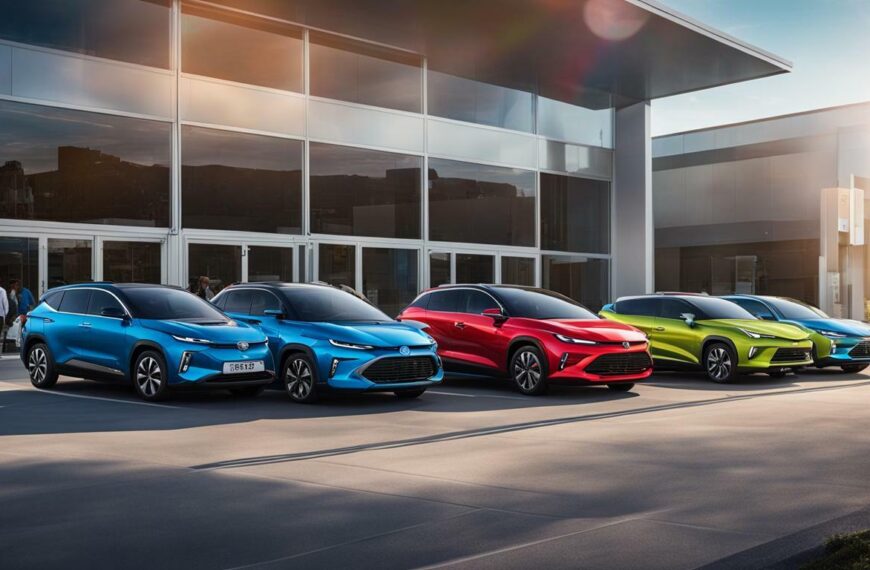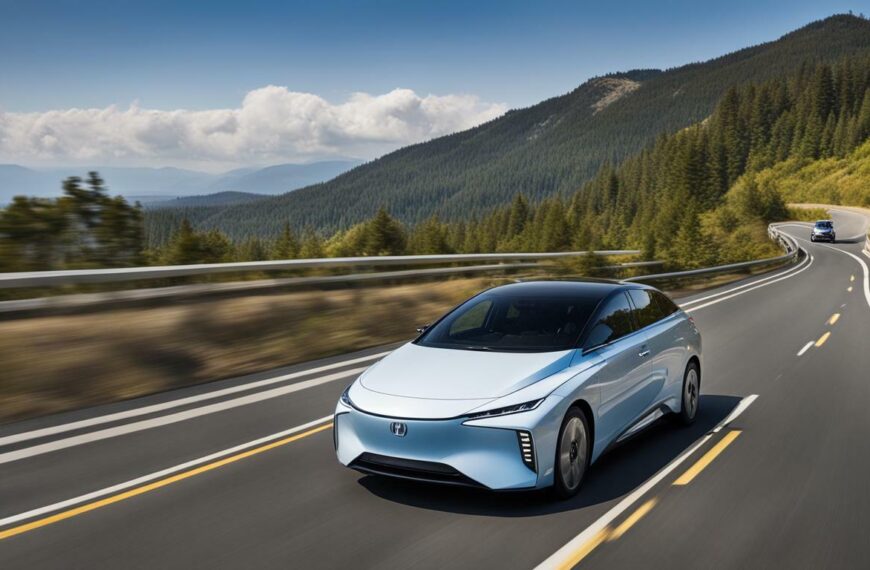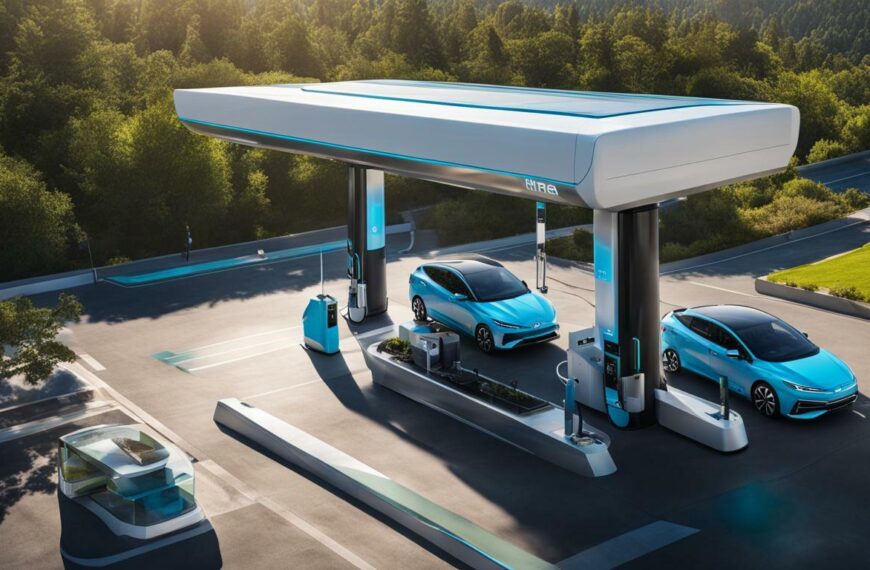Hydrogen from wind and solar is poised to become the leading clean fuel of the future, offering a sustainable energy solution for a carbon-free world. Companies like Engie are already utilizing wind and solar farms to create renewable hydrogen that can be blended into natural gas streams.
The European Commission is also supporting renewable hydrogen as part of its strategy to achieve net-zero carbon emissions by 2050. Hydrogen can play a crucial role in decarbonizing the electric grid and heavy industries, providing backup power during periods of low renewable energy availability.
However, there are challenges to overcome, such as the limited capacity of electric grids and the need for cost-effective storage and transportation of hydrogen. Nevertheless, hydrogen produced from wind energy has the potential to become a significant component of a zero-carbon world.
Key Takeaways:
- Hydrogen from wind and solar is a clean and sustainable fuel source for the future.
- Companies like Engie are already using wind and solar farms for renewable hydrogen production.
- The European Commission supports renewable hydrogen as part of its carbon emissions reduction strategy.
- Hydrogen can help decarbonize the electric grid and heavy industries.
- Hydrogen offers backup power during periods of low renewable energy availability.
Utilizing Hydrogen from Wind and Solar Farms
Companies like Engie are pioneering the use of wind and solar farms to produce renewable hydrogen, paving the way for a greener and more sustainable future. By harnessing the power of wind and solar energy, these companies are able to generate electricity that is then used to electrolyze water, producing hydrogen. This renewable hydrogen can be blended into natural gas streams, offering a clean and low-carbon alternative to traditional fossil fuels.
Renewable hydrogen, also known as green hydrogen, holds tremendous potential in reducing carbon emissions and transitioning towards a sustainable energy system. When produced from wind and solar farms, hydrogen becomes a valuable energy carrier that can be used to power various sectors, including transportation and industrial processes. It offers a clean, efficient, and versatile solution that aligns with the growing global demand for renewable energy.
The European Commission has recognized the importance of renewable hydrogen and its role in achieving a carbon-neutral future. Through its support, the Commission aims to foster innovation, investment, and collaboration to drive the development and widespread adoption of renewable hydrogen technologies. By leveraging the power of wind and solar farms, the European Union is taking significant strides towards realizing its ambitious climate goals.
| Benefits of Utilizing Wind and Solar Farms for Hydrogen Production |
|---|
| Reduces greenhouse gas emissions |
| Enables the decarbonization of the electric grid and heavy industries |
| Provides backup power during periods of low renewable energy availability |
| Contributes to a more sustainable and resilient energy system |
While the utilization of wind and solar farms for hydrogen production offers numerous benefits, there are challenges that need to be addressed. The limited capacity of electric grids poses a hurdle in scaling up renewable hydrogen production, requiring investments in grid infrastructure to accommodate increased production and distribution. Additionally, cost-effective storage and transportation solutions for hydrogen are essential to ensure its efficient deployment across different sectors.
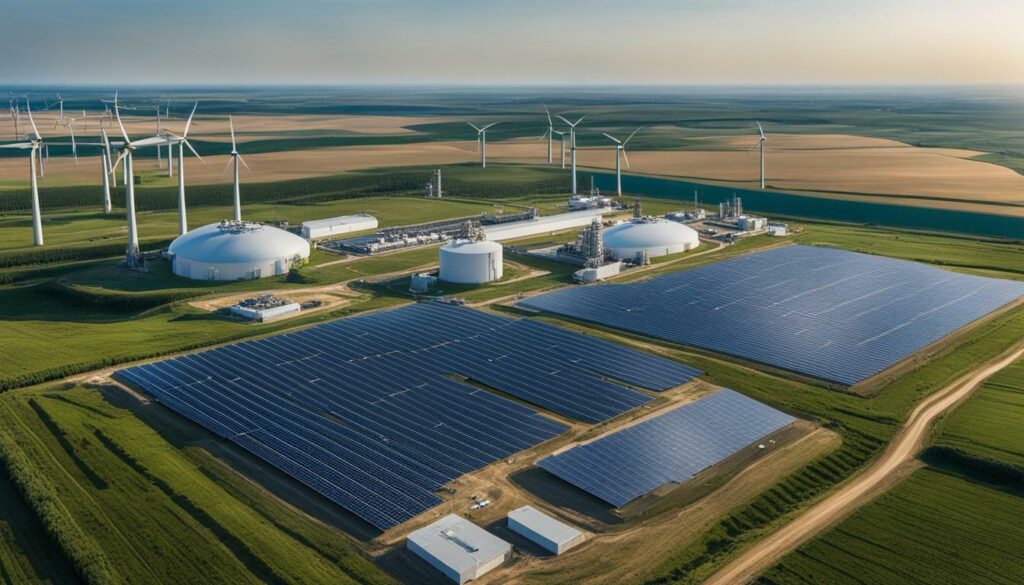
Despite these challenges, the potential of hydrogen produced from wind and solar energy cannot be underestimated. As countries around the world strive to transition to a zero-carbon future, renewable hydrogen offers a promising pathway towards achieving clean and sustainable energy systems. By integrating wind and solar farms into the hydrogen production process, we can unlock a greener and more sustainable future for generations to come.
Support for Renewable Hydrogen by the European Commission
The European Commission recognizes the potential of renewable hydrogen in achieving its ambitious carbon reduction goals, providing crucial support for the development of sustainable hydrogen production. As part of its strategy to achieve net-zero carbon emissions by 2050, the Commission has identified renewable hydrogen as a key component in decarbonizing the energy sector and reducing greenhouse gas emissions.
Renewable hydrogen, produced from sources like wind and solar power, offers a carbon-free alternative to traditional fossil fuel-based energy sources. It can be used in various applications, including fuel cells for transportation, power generation, and industrial processes. By supporting the development of renewable hydrogen technologies, the European Commission aims to accelerate the transition to a clean and sustainable energy future.
One of the key initiatives of the European Commission is the European Clean Hydrogen Alliance, which brings together industry leaders, government representatives, and research institutions to promote the use of renewable hydrogen. Through this alliance, the Commission aims to facilitate investments and create a favorable regulatory framework for the development and deployment of renewable hydrogen projects across Europe.
The European Commission’s support for renewable hydrogen not only aligns with its climate objectives but also opens up opportunities for job creation, economic growth, and technological innovation. By investing in sustainable hydrogen production, Europe can lead the global transition to a carbon-free economy while ensuring energy security and reducing dependence on imported fossil fuels. The path towards a zero-carbon world requires concerted efforts, and the European Commission’s commitment to renewable hydrogen is a step in the right direction.
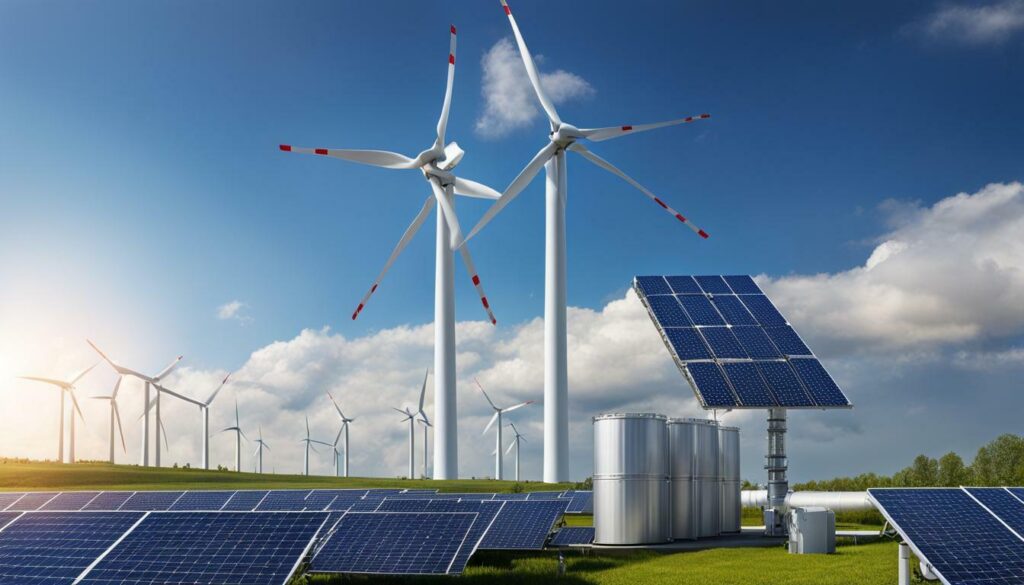
Decarbonizing the Electric Grid and Heavy Industries
Hydrogen has the potential to revolutionize the decarbonization of both the electric grid and heavy industries, offering a sustainable and carbon-free energy solution. By utilizing hydrogen fuel, we can significantly reduce greenhouse gas emissions and transition towards a cleaner and more sustainable energy future.
One of the key advantages of hydrogen is its versatility. It can be used as a direct replacement for fossil fuels in power generation, providing a clean and efficient source of energy for the electric grid. Additionally, hydrogen can be utilized in heavy industries such as steel production, chemical manufacturing, and transportation, helping to eliminate carbon emissions in sectors that are traditionally hard to decarbonize.
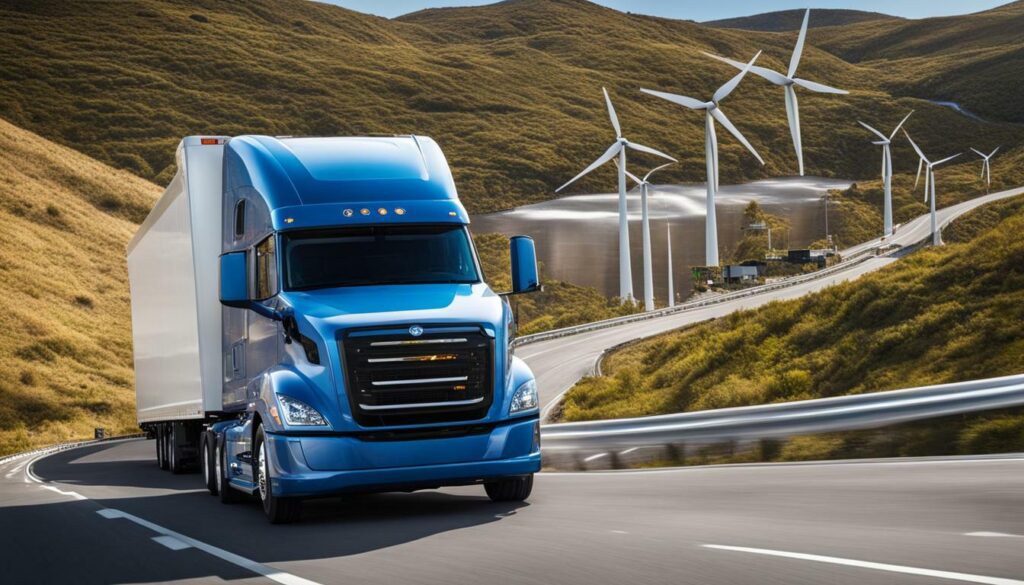
Renewable power sources, such as wind and solar, play a crucial role in hydrogen production. These sources are abundant, widely available, and emit no greenhouse gases during operation.
Benefits of Hydrogen Fuel:
- Reduces carbon emissions and helps combat climate change
- Diversifies the energy mix and reduces dependency on fossil fuels
- Enables the integration of renewable energy sources into the electric grid
- Provides a viable solution for decarbonizing heavy industries
However, there are challenges that need to be addressed for widespread adoption of hydrogen fuel. One such challenge is the limited capacity of electric grids to accommodate the increased demand for hydrogen-powered technologies. Furthermore, cost-effective storage and transportation of hydrogen are significant barriers that need to be overcome.
| Challenges | Solutions |
|---|---|
| Limited capacity of electric grids | Investing in grid infrastructure upgrades and smart grid technologies |
| Cost-effective storage and transportation | Developing advanced storage solutions and dedicated hydrogen transportation infrastructure |
Despite these challenges, the immense potential of hydrogen produced from wind energy makes it a promising component of a zero-carbon world. As we continue to invest in research, innovation, and policy support, we can further unlock the benefits of hydrogen fuel, accelerating the global transition towards a sustainable and clean energy future.
Backup Power During Low Renewable Energy Availability
Hydrogen can serve as a reliable backup power source during times when renewable energy availability is limited, ensuring a continuous supply of energy. As wind and solar power are intermittent energy sources, there may be periods when their output is reduced, such as during calm days or nights. However, by producing renewable hydrogen during times of excess energy generation, we can store this clean fuel to be used later when renewable resources are not producing enough electricity. This ensures that there is a reliable backup power option that helps to bridge the gap between energy demand and supply.
One way to store renewable hydrogen for backup power is through compressed hydrogen tanks. These tanks can store large amounts of hydrogen, which can be used to fuel power plants or other energy-intensive industries when renewable energy availability is low.
In addition to providing backup power, renewable hydrogen also offers the advantage of producing zero emissions. When hydrogen is burned as a fuel, it only produces water vapor as a byproduct, making it completely clean and environmentally friendly. This is in stark contrast to traditional backup power sources, such as fossil fuels, which release harmful greenhouse gases into the atmosphere and contribute to climate change.
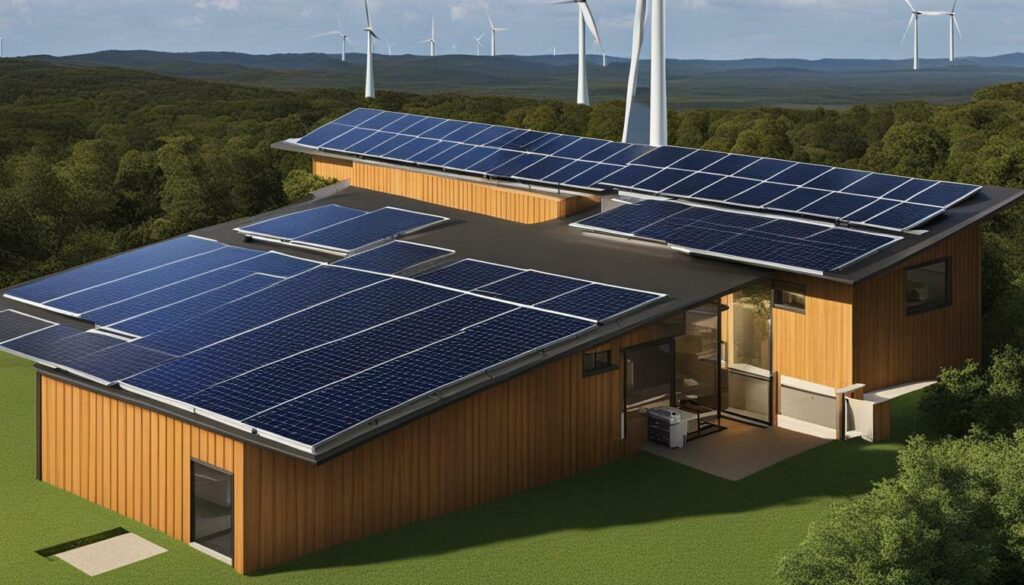
Ultimately, having a reliable backup power source is crucial for maintaining a stable and resilient energy system. By utilizing renewable hydrogen, we can ensure that even during periods of low renewable energy availability, we can meet the energy demands of society while minimizing our carbon footprint. This is a key step in the transition towards a sustainable and clean energy future.
Challenges and Opportunities in Hydrogen Production
While there are challenges to overcome in hydrogen production from renewable resources, there are also significant opportunities for clean energy production and innovation. One of the main challenges lies in the limited capacity of electric grids to handle the influx of renewable energy sources such as wind and solar power. The intermittent nature of these energy sources poses a challenge to the continuous production and storage of hydrogen. However, advancements in energy storage technologies, such as large-scale batteries and innovative hydrogen storage systems, are being developed to address this issue.
Another challenge is the cost-effective transportation of hydrogen. Hydrogen is a light and highly flammable gas, making it difficult to transport safely across long distances. However, there are promising solutions in the form of hydrogen pipelines and the conversion of hydrogen into liquids like ammonia for easier transportation. The development of a widespread hydrogen infrastructure will require significant investment and collaboration between industry stakeholders and policymakers.
Amidst these challenges, there are numerous opportunities for clean energy production and innovation. The production of hydrogen from renewable resources presents an environmentally friendly alternative to fossil fuels. By harnessing the power of wind and solar energy, we can produce hydrogen without emitting greenhouse gases or contributing to climate change. This paves the way for a sustainable and carbon-free energy future.
| Challenges | Opportunities |
|---|---|
| Limited electric grid capacity | Advancements in energy storage technologies |
| Cost-effective transportation | Development of hydrogen infrastructure |
| Intermittent nature of renewable energy sources | Environmentally friendly energy production |
As the demand for clean energy continues to grow, the opportunities for hydrogen production from renewable resources will only increase. By investing in research and development, we can improve the efficiency and scalability of hydrogen production methods. This will not only drive the transition to a low-carbon economy but also create new job opportunities and stimulate economic growth.
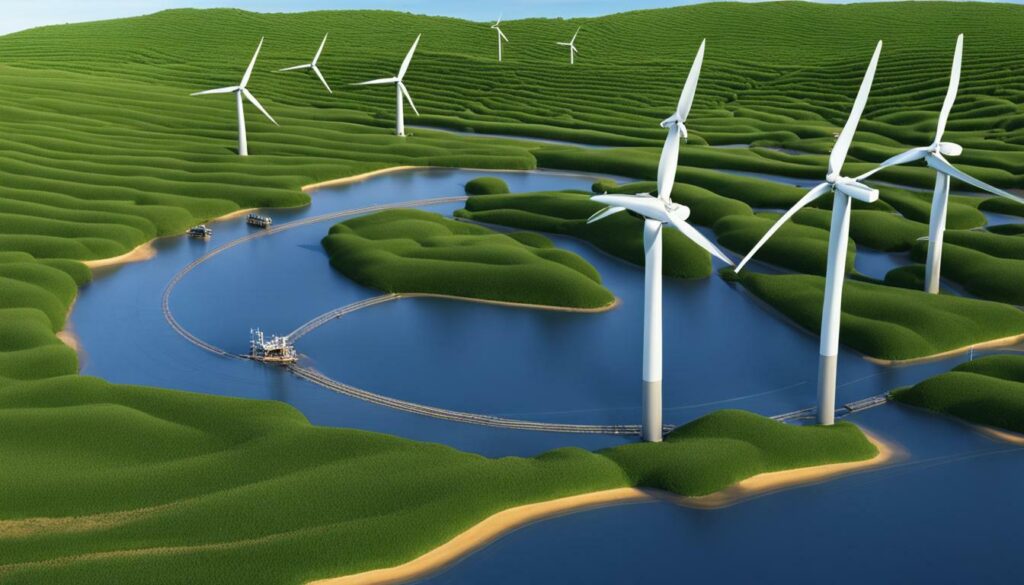
In conclusion, while there are challenges to overcome in hydrogen production from renewable resources, such as limited electric grid capacity and cost-effective transportation, the opportunities for clean energy production and innovation are immense. By addressing these challenges and capitalizing on the opportunities, we can pave the way for a sustainable and carbon-free future powered by hydrogen.
The Potential of Wind Energy in Hydrogen Production
Wind energy holds tremendous potential in the production of renewable hydrogen, offering a sustainable and abundant source of power. By harnessing wind power through advanced technologies, we can generate vast amounts of clean energy that can be used to produce hydrogen, a versatile fuel with numerous applications. Wind farms, with their towering turbines, capture the kinetic energy of the wind and convert it into electricity, which can then be used to power electrolyzers that produce hydrogen through the process of water electrolysis.
This renewable hydrogen can be stored and transported, providing a viable solution for backup power during periods of low renewable energy availability. By blending renewable hydrogen with natural gas streams, we can reduce carbon emissions and transition towards a cleaner energy system. Moreover, hydrogen produced from wind energy can play a crucial role in decarbonizing the electric grid and heavy industries, helping to reduce greenhouse gas emissions and combat climate change.
“Wind energy, with its abundance and sustainability, offers a promising pathway towards a zero-carbon world,” says Dr. Sarah Thompson, a leading expert in renewable energy.
While the potential of wind energy in hydrogen production is immense, there are challenges that need to be addressed. The limited capacity of electric grids poses a constraint on the integration of large-scale wind farms. However, advancements in grid infrastructure and energy storage technologies can help overcome these challenges and enable the widespread adoption of wind energy for hydrogen production. Additionally, cost-effective storage and transportation solutions need to be developed to ensure the efficient utilization of renewable hydrogen.
As we strive towards a carbon-free future, harnessing the potential of wind energy in hydrogen production will be crucial. By investing in research, innovation, and policy support, we can unlock the full potential of renewable hydrogen and accelerate the transition towards a sustainable and clean energy system.
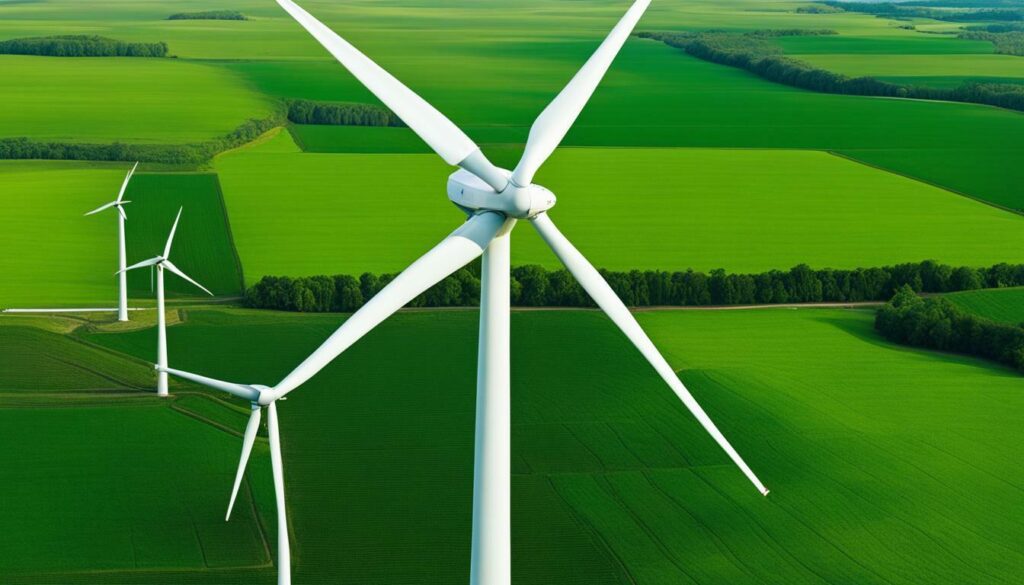
Solar energy is a key player in the production of renewable hydrogen, harnessing the power of the sun to provide a sustainable energy source. Solar panels convert sunlight into electricity, which can be used to power electrolysers for hydrogen production.
By utilizing solar energy, we can tap into an abundant and clean resource to generate hydrogen. This process, known as photovoltaic-powered electrolysis, offers a carbon-free pathway for hydrogen production and helps to reduce our dependency on fossil fuels.
In addition to being environmentally friendly, solar energy is also cost-effective. The installation and maintenance costs of solar panels have significantly decreased over the years, making it a viable option for large-scale hydrogen production. With ongoing advancements in solar technology, the efficiency and affordability of solar-based hydrogen production are steadily improving.
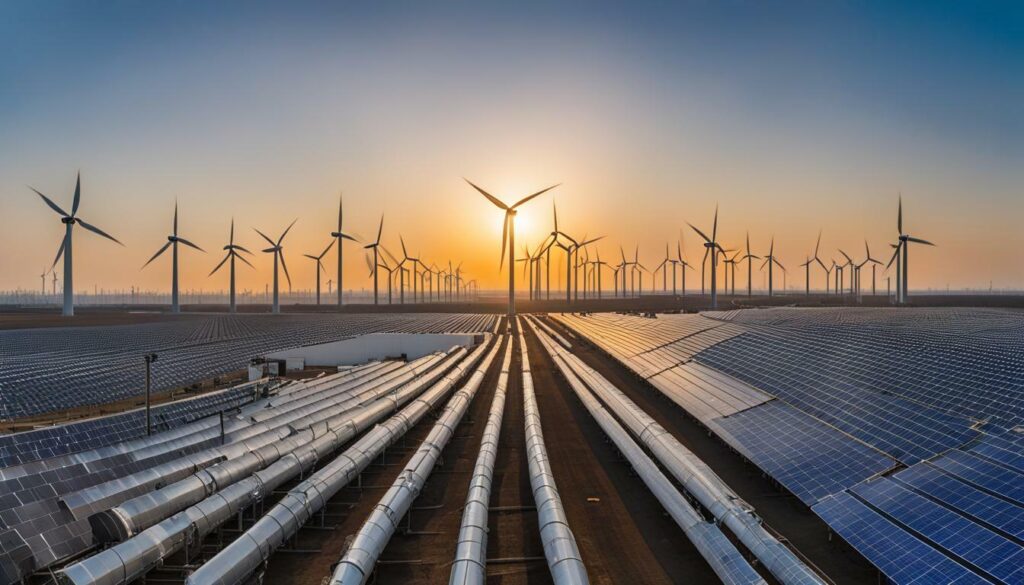
Advantages of Solar-Powered Hydrogen Production
- Sustainable: Solar energy is a renewable resource that does not deplete the earth’s natural reserves.
- Low Carbon Footprint: Solar-powered hydrogen production emits no greenhouse gases, helping to combat climate change.
- Energy Security: Solar energy provides a decentralised energy source, reducing reliance on imported fossil fuels.
- Scalability: Solar panels can be installed on various scales, from residential rooftops to large solar farms, catering to different energy demands.
As we continue to embrace the potential of renewable energy, solar-driven hydrogen production offers a promising pathway towards a sustainable future. By harnessing the power of the sun, we can unlock a clean, abundant, and cost-effective source of hydrogen for a wide range of applications.
The Path Towards a Zero-Carbon World
By harnessing the power of renewable energy sources, particularly wind and solar, hydrogen has the potential to play a significant role in creating a zero-carbon world. With the increasing global concern over carbon emissions and climate change, it is crucial to explore clean energy alternatives. Renewable hydrogen, produced through the electrolysis of water using electricity generated from wind and solar power, offers a sustainable solution for a greener future.
Renewable energy, such as wind and solar, provides a consistent and abundant source of power that can be harnessed to produce hydrogen. This renewable power can be used to electrolyze water, splitting it into hydrogen and oxygen, without emitting harmful greenhouse gases or pollutants. The resulting renewable hydrogen can be utilized in various sectors, including transportation, electricity generation, and industrial processes, helping to reduce carbon emissions and promote a transition towards clean energy.

One of the significant advantages of renewable hydrogen is its versatility as an energy carrier. It can be stored and transported efficiently, making it a viable option for backup power during periods of low renewable energy availability. Moreover, hydrogen power can also decarbonize the electric grid and heavy industries, which are major contributors to global carbon emissions. By integrating renewable hydrogen into these sectors, we can help mitigate the environmental impact and move closer to a carbon-free energy landscape.
While the potential of hydrogen from wind and solar is vast, there are challenges that need to be addressed. The limited capacity of electric grids and the need for cost-effective methods of hydrogen storage and transportation are among the key obstacles. However, with continued innovation, investment, and policy support, these challenges can be overcome. By investing in research and development, scaling up production, and implementing supportive policies, we can unlock the full potential of renewable hydrogen and accelerate the transition towards a zero-carbon world.
| Benefits of Renewable Hydrogen | Applications |
|---|---|
| Reduces carbon emissions | Transportation |
| Promotes sustainable energy transition | Electricity generation |
| Offers backup power during low renewable energy availability | Industrial processes |
| Decarbonizes the electric grid and heavy industries |
- “Renewable Hydrogen: Sustainable Energy for a Greener Future,” Green Energy Society, accessed July 2022, www.greenenergysociety.com/renewable-hydrogen.
- “Hydrogen Production from Renewable Energy Sources,” International Renewable Energy Agency (IREA), accessed July 2022, www.irea.org/hydrogen-production-renewable-energy.
- “Renewable Hydrogen for a Sustainable Future,” World Energy Council, accessed July 2022, www.worldenergy.org/renewable-hydrogen-for-a-sustainable-future.
Addressing the Future of Hydrogen Production
The future of hydrogen production from renewable energy sources holds tremendous promise, but it requires continued investment, innovation, and policy support to ensure its widespread adoption.
Companies like Engie are already at the forefront of harnessing wind and solar farms to create renewable hydrogen that can be blended into natural gas streams. This innovative approach not only contributes to a more sustainable energy transition but also helps reduce carbon emissions. By utilizing wind and solar power, these companies are tapping into the vast potential of renewable energy resources to produce clean hydrogen, which can be used as a fuel for various applications.
Renewable hydrogen is the key to a sustainable and carbon-free future. By utilizing wind and solar power, we can produce clean and renewable energy that will contribute to a greener world. Let’s embrace the potential of hydrogen and work together towards a zero-carbon future.
The European Commission has recognized the importance of renewable hydrogen and is actively supporting its development as part of its strategy to achieve net-zero carbon emissions by 2050. This support will help drive the deployment of renewable hydrogen technologies and accelerate the decarbonization of the electric grid and heavy industries. By promoting sustainable hydrogen production, the European Commission aims to pave the way for a cleaner and greener future.
While the potential of hydrogen from wind and solar is evident, there are challenges to overcome. The limited capacity of electric grids poses a constraint on the large-scale integration of renewable hydrogen into existing energy systems. Additionally, cost-effective storage and transportation solutions for hydrogen are still necessary to ensure its viability as a clean energy source. However, with ongoing research and development efforts, these challenges can be addressed, unlocking the full potential of hydrogen as a key component in the transition to a zero-carbon world.
| Benefits of Hydrogen from Wind and Solar for the Future |
|---|
| Reduced carbon emissions |
| Utilization of renewable energy resources |
| Decarbonization of the electric grid and heavy industries |
| Backup power during periods of low renewable energy availability |
| Contribution to a zero-carbon world |
Wind energy has the potential to become a significant contributor to renewable hydrogen production. The abundance of wind resources coupled with advances in turbine technology makes it a viable and scalable solution for clean hydrogen generation. Harnessing wind power for hydrogen production can significantly reduce greenhouse gas emissions and help achieve sustainable energy goals.
Similarly, solar energy is a crucial player in the future of hydrogen production. With the declining costs of solar panels and increasing efficiency, solar power offers a renewable and abundant source of energy for hydrogen production. By utilizing solar energy, we can tap into a clean and sustainable resource to produce hydrogen, reducing our reliance on fossil fuels and paving the way for a carbon-free energy future.
As we look to the future, it is imperative that we continue to invest in renewable energy technologies and support innovative solutions for hydrogen production. By fostering collaboration between industry, government, and research institutions, we can unlock the full potential of hydrogen from wind and solar power. Together, we can create a sustainable and clean energy landscape that benefits both the present and future generations.
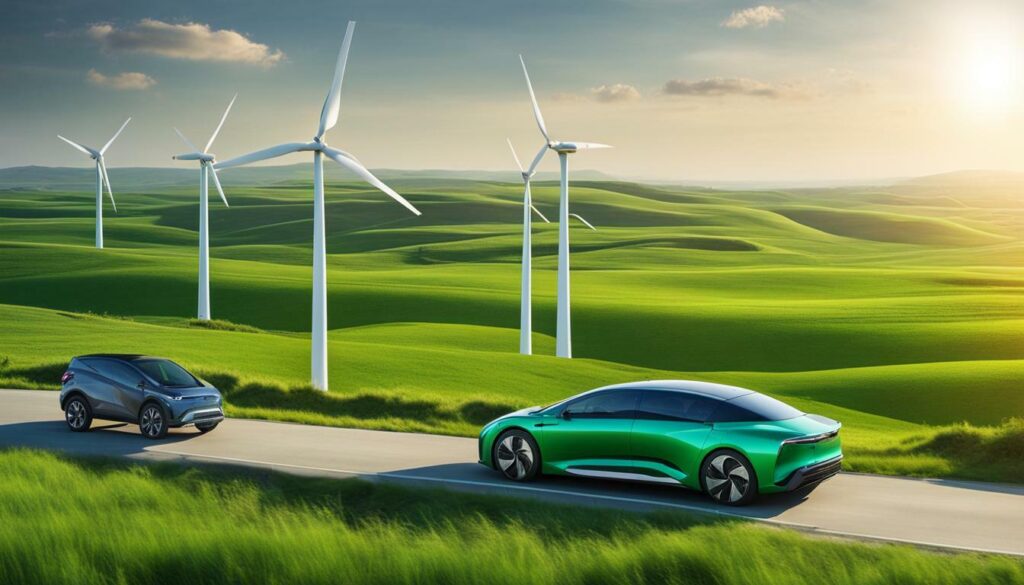
Conclusion
In conclusion, hydrogen produced from renewable energy sources has the power to drive a cleaner, more sustainable future. Companies like Engie are already harnessing wind and solar farms to create renewable hydrogen, which can be blended into natural gas streams. The European Commission’s support for renewable hydrogen further emphasizes its importance in achieving net-zero carbon emissions by 2050.
Hydrogen has the potential to play a crucial role in decarbonizing the electric grid and heavy industries, reducing greenhouse gas emissions and contributing to a cleaner environment. Additionally, hydrogen can provide reliable backup power during periods of low renewable energy availability, ensuring a consistent energy supply.
However, there are challenges that need to be overcome, such as the limited capacity of electric grids and the need for cost-effective storage and transportation of hydrogen. Continued innovation, investment, and policy support are crucial to driving the widespread adoption of sustainable hydrogen as a clean energy solution.
It is up to us to embrace this green energy revolution and pave the way towards a carbon-free world. By investing in renewable energy, supporting hydrogen production, and prioritizing clean and sustainable solutions, we can create a future that is powered by renewable resources and free from harmful carbon emissions.
FAQ
What is the potential of hydrogen from wind and solar energy?
Hydrogen from wind and solar energy has the potential to become a key clean fuel of the future. It can play a crucial role in decarbonizing the electric grid and heavy industries, providing backup power during periods of low renewable energy availability.
How are companies utilizing wind and solar farms for hydrogen production?
Companies like Engie are utilizing wind and solar farms to create renewable hydrogen. These farms harness renewable energy sources to produce hydrogen that can be blended into natural gas streams, contributing to the production of clean and sustainable energy.
How does the European Commission support renewable hydrogen?
The European Commission supports renewable hydrogen as part of its strategy to achieve net-zero carbon emissions by 2050. This support emphasizes the importance of utilizing renewable energy sources for hydrogen production and achieving a sustainable energy transition.
What are the challenges in hydrogen production from renewable resources?
There are challenges to overcome in hydrogen production from renewable resources, such as the limited capacity of electric grids and the need for cost-effective storage and transportation of hydrogen. However, these challenges present opportunities for innovation and investment in clean energy solutions.
What is the potential of wind energy in hydrogen production?
Wind energy has the potential to contribute significantly to hydrogen production. By harnessing wind power, we can generate renewable hydrogen and reduce reliance on fossil fuels, making strides towards a zero-carbon world.
How does solar energy play a role in hydrogen production?
Solar energy can play a critical role in hydrogen production. By utilizing solar power, we can generate renewable hydrogen and meet the growing demand for clean energy, furthering our efforts towards a sustainable and carbon-free future.
What is the path towards achieving a zero-carbon world?
The path towards achieving a zero-carbon world involves transitioning to renewable energy sources, such as wind and solar power, and utilizing hydrogen as a clean fuel. This requires continued innovation, investment, and policy support to drive the widespread adoption of sustainable energy solutions.
What does the future of hydrogen production look like?
The future of hydrogen production from renewable energy sources looks promising. Continued advancements in technology and increased investment in clean energy solutions will pave the way for the widespread adoption of sustainable hydrogen, supporting the transition towards a carbon-free world.
Source Links
- https://www.energy.gov/eere/articles/how-wind-energy-can-help-clean-hydrogen-contribute-zero-carbon-future
- https://www.scientificamerican.com/article/solar-and-wind-power-could-ignite-a-hydrogen-energy-comeback/
- https://www.theguardian.com/environment/2023/mar/07/hydrogen-clean-fuel-climate-crisis-explainer
